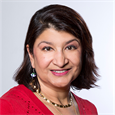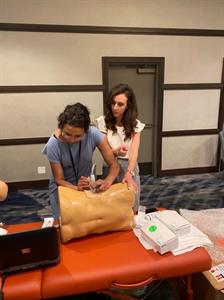 The CSA’s Annual Meeting was in-person this year (the first one since 2019) at the beautiful Mission Bay San Diego Hyatt Regency. It was wonderful to see colleagues and friends and learn new techniques and advances in the field. The resort was gorgeous and family-friendly, the speakers, panels and workshops were excellent and informative, and the weather was wonderful. The full program can be found here. Photos and comments on the meeting can be found on Twitter, Instagram and FB @csahq #CsaAnnual22.
The CSA’s Annual Meeting was in-person this year (the first one since 2019) at the beautiful Mission Bay San Diego Hyatt Regency. It was wonderful to see colleagues and friends and learn new techniques and advances in the field. The resort was gorgeous and family-friendly, the speakers, panels and workshops were excellent and informative, and the weather was wonderful. The full program can be found here. Photos and comments on the meeting can be found on Twitter, Instagram and FB @csahq #CsaAnnual22.
Thursday, April 7 started with a fantastic POCUS workshop that was organized by Engy Said, MD (UCSD). The workshop offered training on a “whole body” ultrasound examination designed to expand all anesthesiologists’ skills with cardiac, pulmonary, abdominal, and vascular ultrasound. The workshop covered the latest topics in regional anesthesia, as well as a review of traditional ultrasound-guided nerve blocks. Dr. Said assembled a world-class group of facilitators, and participants received excellent one-on-one hands-on demonstration. This was as good a workshop as those found at other larger meetings, with much more personal attention.
Said, MD (UCSD). The workshop offered training on a “whole body” ultrasound examination designed to expand all anesthesiologists’ skills with cardiac, pulmonary, abdominal, and vascular ultrasound. The workshop covered the latest topics in regional anesthesia, as well as a review of traditional ultrasound-guided nerve blocks. Dr. Said assembled a world-class group of facilitators, and participants received excellent one-on-one hands-on demonstration. This was as good a workshop as those found at other larger meetings, with much more personal attention.
Friday morning’s sessions dawned bright and early on a gorgeous sunny day. Despite the marvelous weather, the meeting was well attended. The morning session was moderated by Dr. Engy Said and included a review of Acute Pain and Regional Techniques. Rana Movahedi, MD (UCLA) and Kyle Ahn, MD (UCI) reviewed truncal blocks, thoracic epidurals, and lidocaine infusions. These were up-to-date reviews of the literature with high-yield, practice-changing information. Dr. Said (UCSD) and Baher Boctor, MD (Loma Linda) discussed regional techniques for breast and chest wall surgery. They specifically covered serratus plane, ESP and PECS blocks as well as the research supporting their use.
 The next session focused on OB Anesthesia, with a wonderful lively discussion led by session moderator and speaker Ron George, MD (UCSF) on the alphabet soup of labor analgesia: CSE, DPE EPI. Jennifer Woodbury, MD, MBA (UCSF) enlightened us in her talk called “Oh No! A Bad epidural and a Terrible Tracing? Managing Problematic Epidural Catheters in Labor and Urgent Cesarean Section.” It was fascinating, terrifying, and increased my already great respect for my OB colleagues. Pervez Sultan, MBCHB, FRCA, MD (Stanford) and Cristina Gutierez, MD (UCD) concluded the session with truly superb presentations on Post Cesarean Delivery Analgesia and Postpartum Headaches. The Q&A session that followed was interesting and engaging, with many excellent questions asked and answered.
The next session focused on OB Anesthesia, with a wonderful lively discussion led by session moderator and speaker Ron George, MD (UCSF) on the alphabet soup of labor analgesia: CSE, DPE EPI. Jennifer Woodbury, MD, MBA (UCSF) enlightened us in her talk called “Oh No! A Bad epidural and a Terrible Tracing? Managing Problematic Epidural Catheters in Labor and Urgent Cesarean Section.” It was fascinating, terrifying, and increased my already great respect for my OB colleagues. Pervez Sultan, MBCHB, FRCA, MD (Stanford) and Cristina Gutierez, MD (UCD) concluded the session with truly superb presentations on Post Cesarean Delivery Analgesia and Postpartum Headaches. The Q&A session that followed was interesting and engaging, with many excellent questions asked and answered.
During lunch there was a poster session with posters submitted from all over the country. The quality and scientific rigor of these presentations was impressive. This was a great opportunity for residents, fellows, faculty and in some cases college students to present their research or interesting cases to an audience of interested anesthesiologists. There was an additional poster session on Saturday. Congratulations to the following winners:
Alexander Beletsky, MD: “Gender, Race, Insurance Status, Training Hospital Status Predict the Receipt of Regional Anesthesia.”
Misty Montoya, MD, PhD: “Helping Build Our Future Healthcare Workforce: How Stanford Anesthesiology Department and CSA Engaged Community High Schools During the COVID-19 Pandemic.”
Friday afternoon started with the cardiac /critical care session. The brilliant Tariq Naseem, MD (Cedars Sinai) started the session by reviewing VADS management for non-cardiac surgery. This was a timely and important topic since there are increasing numbers of patient with VADS coming to the OR. The equally accomplished Milad Sharifpour MD (Cedars Sinai) followed with a discussion on Atrial Fibrillation and Perioperative Management. Both of these dedicated speakers drove down post-call from LA just to present at the meeting. Session moderator Ioana Pasca, MD (LLMUC, Riverside) shared a fascinating talk on Tips and Tricks for Managing Cardiac Disease for Non-Cardiac Surgery, while Jay Shen (UCI) updated the audience on ARDS. As with all the other sessions, the question-and-answer panel was rich and engaging. The expertise of the speakers and the various institutions they represented led to very satisfying and informative discussions.
The rest of the afternoon was a wonderful display of up-and-coming research, from both established faculty, as well as future physicians and researchers. The first session organized and moderated by Ashley Broussard, MD (UCI) allowed the authors of the top 8 abstracts to present their work. Dr. Broussard reviewed all the abstracts and posters and helped a panel of judges from CSA leadership select the oral abstract winners. In addition, the winner of the CSA History of Anesthesia Essay Contest Todsaporn (Bob) Rodbumrung, MD, presented his essay called “Fortune Favors the Prepared Mind: The First Use of IV Dantrolene to Treat Malignant Hyperthermia in an Adult Patient.” CSA History Essay Winner
The top 3 winners of the Oral Abstract Presentations were:
1st place: Amy Tsai, BA, UC Davis School of Medicine. “Prediction of surgical site complications with single-call and plasma proteomic modeling.”
2nd place: Sonia Wraich, BS, Loma Linda University Medical Center. “Assisted Laparoscopic Prostatectomy: A Quality Improvement Comparison to Conventional Opioid Management.”
3rd place: Steven Abboud, MD, Stanford University. “Suprazygomatic Maxillary Nerve Block for Pediatric Adenotonsillectomy: A Randomized Control Trial.”
The last session of Friday utilized an innovative approach to try and get the audience engaged. The moderators of many of the sessions (Drs. Said, George, Pasca, Broussard, Doyle, Agarwal and Leong) chose and presented the top recent articles in their specialty or related to their panel. The audience was then asked to choose which article they thought was the most influential. An update of the latest and most important literature by experts in the field? What could be better, especially at the end of a long and educational day?
Many of Saturday’s sessions have been wonderfully reviewed by Dr. Jane Moon CSA Annual Meeting Leffingwell Lecture, Diversity in Anesthesia. In addition to the session highlighted in Dr. Moon’s CSAOF, Randy Clark MD, FASA, the current ASA President, gave an update on recent ASA activities, including lobbying for improved Medicare payments, negotiating for improved surprise billing resolution disputes, and the ASA’s desire to increase diversity, mentorship and sponsorship.
Saturday afternoon’s Pediatric session was a fast paced and fun event. Each speaker gave 15-minute presentations on Common Challenges in Pediatric Patients. The panel included physicians from private and academic practices from all over the country. Rita Agarwal, MD, (Stanford) presented on perioperative management of the patient with chronic pain. Olubukola Nafiu, MD, FRCA, MS, (Nationwide Children’s Hospital, Columbus, OH) discussed the risks of obesity in a child presenting for an urgent femur fracture. Pragati Rohatgi, MD, (CASE Medical Group/Sutter Medical Center) reviewed tips and tricks for tonsillectomy in private practice. Alyssa Brzenski, MD, (UCSD) gave an overview of the risks and benefits of caring for a COVID positive, asymptomatic patient presenting for surgery. Sheila Rajashekra, MD, (Rady Children’s Hospital) presented the intricacies and deliberate approach to caring for children with congenital heart disease. Last but by no means least, Dr. Randy Clark (Children’s Colorado/University of Colorado), ASA President and my former chief and colleague, debated the advantages and disadvantages of private versus academic practice in pediatrics. As expected, this was followed by an interactive and lively question and answer panel.
Sunday was dedicated to pain-related topics and was designed to help California physicians (and those from other states with similar requirements) fulfill their state medical license pain CME requirement. Michael Leong, MD, (Stanford) organized the day as a stand-alone event for anesthesiologists, as well as interested non-anesthesiologists. The morning started with Ravi Prasad, PhD, (UCD), discussing the challenges and future of telehealth for pain management. While the convenience of virtual visits is undeniable, he elaborated on some of the difficulties (access, equipment, connectivity, etc). Ed Mariano, MD, MAS, FASA, (Stanford) presented the importance of Transitional Pain Services in decreasing both chronic or persistent pain and opioid misuse. Tiffany Mathias, MD, MBA, (Private Practice) reviewed the use of buprenorphine for acute and chronic pain management and discussed its use in medication-assisted treatment for patient with opioid use disorder. Dr. Leong and Aric Steinmann Lt COL, MD, SFS (Joint Base Elmendorf-Richardson, USAF) gave a fascinating presentation on Long Covid and its Effects on Chronic Pain, both in patients with existing pain and those who have developed pain as a result of COVID. The Q&A session focused on the changing waiver requirements for buprenorphine, and the use of stellate ganglion blocks for long COVID symptoms.
Mark Wallace, MD, (UCSD) then gave 2 amazing lectures, the first on Cannabinoid Use in Perioperative Care, the second on Medical Legal Issues and Pain Management. While there is a lot of great anecdotal evidence for the use of cannabinoids in pain management, there are fewer high quality, RCT, double blind studies. Carlos Pino, MD, FASA, (Uniformed Services university, Naval Medical Center) gave an absolutely fantastic talk on Low Back Pain and Spaceflight. He described the incidence of low back pain in returning astronauts and its potential causes. It was out of this world. The final talk of the day was by Joshua Prager, MD, (UCLA, private practice) who kept the audience rapt despite being the last speaker. His discussion on Outpatient Ketamine Use was eye-opening and thought-provoking. Ketamine appears to have a role in outpatient pain medicine; however, there are still many questions regarding optimal use, dose, duration, etc. The final Q&A session was well attended, and many great questions were discussed.
Thank you to all the amazing moderators who helped organize the meeting, the speakers who gave such wonderful and informative talks, and the audience who attended. Hopefully we will see many more of you next year.

